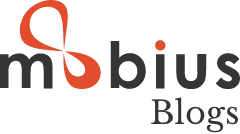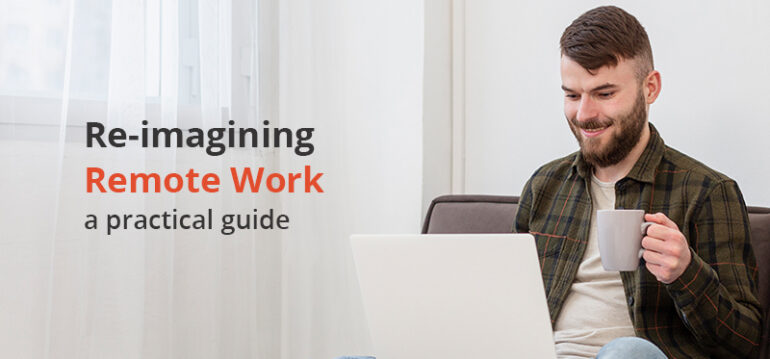“The times change, and we change with them” [Tempora mutantur, et nos mutamur in illis] Ovid (Circa 50 BC)
Change is inevitable but at the same time never comfortable, and this is true for business too. But then, when a big jolt like Covid19 happens, our survival instinct takes over for us to quickly embrace the change and life is never the same again. Infact, the business buzzword you hear in every direction is ‘New Normal’, the supposed aftermath of Covid19 though no one is really expands on what it will look like. This is a post about what and how of a ‘new normal’ we embraced, thanks to the remote work forced upon us.
Just to set the context, I run Mobius, a technology and shared services company of about thousand employees and with about eighty customers around the world. When we surveyed our employees recently (mostly based in three locations in India) who had to suddenly transition to work from home, a surprising feedback for us was that most preferred to continue to work from home if they had a choice. Of course, when we were forced into this transition in March, our well rehearsed business continuity plan (BCP) was smoothly set in motion with no disruption in our deliverables but we also expected to be back in office in couple of weeks. But after a few months now, clearly the employees’ voice was for to continue work from home if possible, and we were like “why not?”
This would be a big disruptor for us, a bootstrapped company that had grown incrementally from five employees to a thousand. So, we had multiple internal debates discussing this possibility from different perspectives, mainly from the customer, managerial and compliance angles. Our employees were mostly from smaller towns and their roles spread across different processes and functions, requiring deep analyses and planning. There were many obvious hurdles to make this work but we could also see creative options to solve each one of them. One major advantage we could leverage was our AI based workflow and automation platforms which mitigated a lot of risks. Thus started our plans for re-imagining our future work/space model.
The New Work-Place Model
We first analyzed the work processes from a complexity, confidentiality and collaboration perspective on one side and from the other, what processes need to be necessarily done in the office and by employees and what need not. This is the framework we came up with:
- On the X-axis, we had ‘tenured employees’ at one end and ‘freelancers’ at the other.
- On the Y-Axis, we had ‘corporate styled offices’ at one end, and ‘remote/work from home’ at the other.
This fit in nicely with the different ways in which we could reimagine our work and the places from which it can be enabled. We were clear this should work well when things get back to business as usual too. Here’s how the different models work…
Corporate Offices & Core Employee Groups (Quadrant-4): This is the traditional model of continuing to work from our three main offices where we still expect about a fourth of our employees to work from. Having our own fully equipped offices was important for multiple reasons including
- Core teams: For enabling the right atmosphere for our strategic teams working on our core IPs that require a lot of collaboration and innovation;
- Business Continuity: for enabling BCP, with robust infrastructure having multiple back-ups and security systems;
- Secure Projects: For customer mandated project teams that have to work in highly secure spaces or processes that require specialized infrastructure like our call center teams.
Hub & Spoke Micro offices model (Quadrant -1): This is a new evolution model that envisages our own employees but working remotely from small neighbourhood offices that are dotted across different towns. These could be small dedicated offices or co-working spaces across multiple small town locations, closer to our employees cluster. Thanks to Covid, many of our customers are also comfortable with us getting work done from remote locations. The advantages we see here are:
- Own employees: Continue to have the security of our own employees for confidentiality of our own IPs or clients’.
- Work-life balance: Employees get the flexibility to work from micro offices reducing their commutes as well as giving them the option to stay at low cost locations. This could also give them the flexibility to alternate work-from-home and visit the neighbourhood office a few times a week
- Collaboration & team work: Having a neighborhood office with all the infrastructure for video conferencing, secure systems and facilities for training, scheduled in-person team collaboration meetings provide the balance between remote work and team bonding.
- Taking tasks to where the talent is: Helps to staff the project where the talent is available rather than putting huge efforts to attract them to move to a different city. This can help reduce staff attrition and also globalize the workforce.
The Franchisee/Partner model (Quadrant -2): This is a radical idea but something we have experimented in the past. Here we encourage some of our tenured employees or a known entrepreneur, working in remote, low cost locations to build a team of contractors. Mobius will invest in the workspace, equipment and ensure compliance to its systems & processes. This model involves this quasi-entrepreneur taking responsibility for a small team (say between 5-15 members) to train, manage and get them to deliver work based on a unit-price model for our projects. The advantages are..
- Process security & standardization: This model is possible for most projects thanks to our AI/Automation based Mojo Platform which our core team uses to process critical steps that involve our IP. Only the downstream work of broken-down simpler process steps alone is passed on to these franchisee work teams.
- Extended, dependable workforce: Many processes would benefit from having an experienced team that is able to manage the nuances well, which works here thanks to a dedicated team. They get trained on our tools for easy project rotations.
- Variable pricing model & seasonality: Helps manage the seasonality and other volume variabilities. Since it is processed through our AI platform, it has the additional benefits of productivity improvement, transparency and most importantly cost advantages that get passed on.
- Taking wealth creation to rural areas: This helps with rural talent identification and training and building local entrepreneurs who act as force multipliers. This model could also work with a rural entrepreneur who is not necessarily an employee but trained by the organization.
The Crowdsourcing model (Quadrant -3): This is a totally hands-off model of using freelancers to deliver from anywhere in the globe, very similar to the Amazon Mechanical Turk model. In this case, the core work of automation is done at our main offices and the byte sized tasks are directly pushed freelancers anywhere in the world.
Our difference here are…
- Delivery Responsibility: Unlike pure freelancing, our organization takes the responsibility of workflow and automation solutioning, project cost and deliverables of quality and turn-around times.
- On-demand & APIfication: Increasingly our customers are turning away from the ‘FTE’ or ‘project’ business model to one of an ‘on demand’ business model of just paying for information or data as and when required, typically using an API. This model helps us build and maintain a data repository where the data volume and refresh rates can be benchmarked to the best but at a lower cost.
- Gamification: Using our ML based solutions like our data refresh platforms, but having a last mile human curation to ensure quality and coverage needs a large workforce. However, by simplifying the tasks and gamifying them ensures the freelanced/crowd sourced teams to work on them, significantly increasing the ability to scale, globalize and cost-cutting considerations.
Current Status:
We are piloting the micro-office model and the franchise model from July with our internal projects and hope to expand roll-out from October. While these are models we had experimented in the past and have no doubts about the efficacy, the real work lies in the area of re-working our people policies, practices and cultural expectations for the different scenarios. We need to re-imagine everything right from hiring, training, team play, collaboration, performance evaluation, job rotation and so on. An internal team is working on the policies and will monitor those through the pilot phase. I’m sure there are going to be learnings and struggles but we can see the benefits outweigh the challenges significantly.
The modern organization’s structure and hierarchy hasn’t changed much from the industrial revolution days.
The ability to reduce costs, improve employee comfort and get better talent, make this a big game changer and win-win-win for our customers, employees and the organization. With the changes in technology and the services economy, this is the right time to break the outdated shackles of history to deliver innovation and competitive advantage in the new era…or we should say, in the New Normal!
This article was originally published on Linkedin
KK
CEO & Co-founder








